Empower Yourself with Nutrition Know-How
(Family Features) Eating a balanced diet with fruits, vegetables, whole grains, dairy and proteins is a crucial first step toward a healthy life.
Even with hectic schedules and convenience foods readily available, it’s important to incorporate habits like regular family meals and meal planning so you have a variety of better-for-you snacks and recipes on hand. Also important is leading by example and modeling healthy eating habits to help improve overall nutrition for you and your family members, especially children.
If you are looking for ways to make nutrition fun, the experts at Healthy Family Project, along with its fruit and vegetable partners, are offering an online nutrition resource center as part of Mission for Nutrition 2024.
Geared toward dietitians, nutrition professionals and anyone involved in nutrition education, the resource center is a one-stop shop to make nutrition education fun and inspiring, featuring more than 600 dietitian-approved recipes; tips to pick, prepare and store more than 50 fruits and vegetables during every season; a podcast, e-cookbook and monthly newsletter; and free downloadables, infographics, activities for kids and more.
Dietitians and nutrition professionals can sign up to receive this year’s Mission for Nutrition kit, which is full of resources to use in classrooms, in-store with customers or wherever they’re supporting nutrition education. Available by request only, the kit includes a roll of “I’m a Healthy Eater” stickers, seasonal counter cards, mini magazines, demo ideas, a Healthy Family Project spatula and additional resources and information from produce partners.
As part of the mission, the partner brands are making a donation to improve access to fresh produce in schools through the Foundation for Fresh Produce.
To find more resources, tips and recipes to encourage proper nutrition, visit HealthyFamilyProject.com.
Photo courtesy of Shutterstock
Source: Healthy Family Project
Give Your Brain a Boost: 5 ways to promote brain health
(Family Features) When it comes to staying healthy, there is a natural emphasis on physical fitness. However, it’s important to know that nurturing and maintaining brain health is also important for leading a fulfilling life.
The brain is the command center of the human body and as such, influences every aspect of life. Maintaining brain health requires providing it with nourishment, rest and healthy stimulation.
Consuming healthy, whole foods, including vegetables and fruits, such as grapes, can help establish a strong foundation for brain health. For example, grapes may help protect against metabolic decline in the brain associated with natural aging; in a human study of elderly subjects with mild cognitive decline, UCLA researchers found consuming 2 1/4 cups of grapes every day preserved healthy metabolic activity in regions of the brain associated with early-stage Alzheimer’s disease, where metabolic decline takes hold.
Adding grapes to your favorite healthy recipes, or enjoying them as a simple snack, helps support a healthy brain. Consider these additional ways to promote positive brain health from the experts at the Mayo Clinic.
Sleep Well
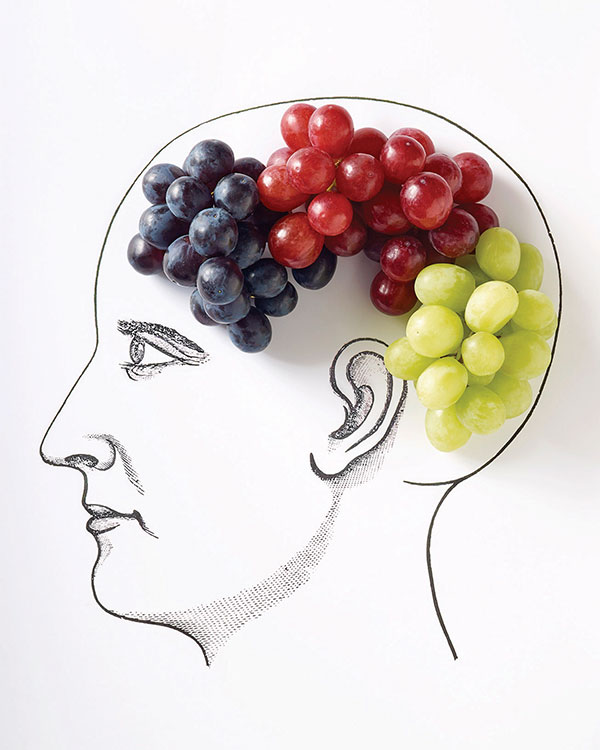 Health experts recommend aiming for at least seven hours of sleep per night. As noted by the Mayo Clinic, adequate sleep may help boost overall memory and brain health by giving the brain time to effectively consolidate memories.
Health experts recommend aiming for at least seven hours of sleep per night. As noted by the Mayo Clinic, adequate sleep may help boost overall memory and brain health by giving the brain time to effectively consolidate memories.
Follow a Healthy Diet
Eating nutritiously benefits the body in many ways, including playing a role in brain health. Healthy eating plans like the Mediterranean diet, which emphasizes plant-based foods, whole grains, fish, healthy fats, fruits and vegetables, are thought by experts to be especially beneficial. Recipes like Warm-Spiced Chickpeas and Couscous with Grapes and Arugula deliver an array of ingredients to support brain health in delicious ways. This recipe is also heart smart because what is good for the heart is also good for the brain.
Stay Social
Keep in touch with family and friends. According to health experts, including the Mayo Clinic, staying connected and interacting socially can help defend against depression and stress, which may contribute to memory loss.
Exercise Regularly
Staying physically active provides well-known benefits for the body, and exercising can also benefit the brain by increasing blood flow to it. Once your workout is over, turn to a post-workout snack like Grapes from California for an energy boost and natural hydration.
Keep Your Mind Active
Like muscles throughout your body, the brain should be used continuously to strengthen it. With nearly endless ways to stimulate the mind, there’s something for everyone to keep their brains in shape from crossword or jigsaw puzzles to reading, learning a new language, playing cards or conquering sudoku.
To find more information about the connection between grapes and health, or discover nutritious recipes, visit GrapesfromCalifornia.com.
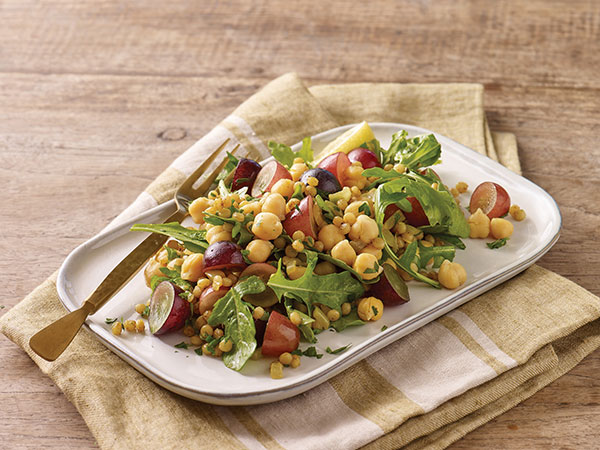
Warm-Spiced Chickpeas and Couscous with Grapes and Arugula
Prep time: 10 minutes
Cook time: 20 minutes
Servings: 4
- 2 tablespoons extra-virgin olive oil
- 1 small onion, chopped
- 1 1/2 teaspoons ground cumin
- 1/2 teaspoon kosher salt, plus additional, to taste, divided
- 1/8 teaspoon ground allspice
- 1 cup Israeli pearl couscous
- 3/4 teaspoon ground turmeric
- 1 1/2 cups water
- 1 can (15 ounces) no-salt-added chickpeas (garbanzo beans), drained
- 1 cup red Grapes from California, halved
- 2 tablespoons chopped fresh cilantro or parsley
- freshly ground black pepper, to taste
- 4 cups lightly packed baby arugula
- lemon wedges
- In large saucepan over medium heat, heat oil. Add onion, cumin, 1/2 teaspoon salt and allspice; cook, stirring, until onion is softened, about 3 minutes. Add couscous and stir 1 minute to toast lightly. Add turmeric and water; bring to boil. Reduce heat, cover and simmer until couscous is tender, about 15 minutes.
- Stir chickpeas, grapes and cilantro into couscous then season with salt and pepper, to taste. Transfer couscous-grape mixture to large bowl, add arugula and toss well. Serve warm or at room temperature with lemon wedges.
Nutritional information per serving: 370 calories; 12 g protein; 61 g carbohydrates; 9 g fat (17% calories from fat); 1 g saturated fat (2% calories from saturated fat); 0 mg cholesterol; 160 mg sodium; 8 g fiber.
Natural Ways to Get a Good Night’s Rest
(Family Features) With nearly one-third of Americans suffering from sleep disturbances, according to research from the Centers for Disease Control and Prevention, now is the time to rethink your bedtime routine and consider more natural ways to get a good night’s rest.
However, implementing those changes doesn’t have to mean overhauling the way you live. Consider these simple tips that can help you sleep better and longer:
Set a comfortable temperature. Making changes in different aspects of your life to achieve better sleep is a fine plan, but it may not make much difference if you aren’t comfortable in your own bed. Be sure to maximize comfort for a full night of sleep by finding a temperature that works for you, but in general, the National Sleep Foundation recommends a bedroom temperature between 60-67 degrees F.
Tweak your diet. Making simple changes to what you eat and drink can be a positive health-conscious decision, including helping you get better sleep. For example, Montmorency tart cherries, which are available year-round, are one of the few natural food sources of melatonin, a sleep-regulating hormone. New research from the American Journal of Therapeutics shows that insomniacs who drank U.S.-grown Montmorency tart cherry juice for two weeks extended sleep time by 84 minutes.
Consuming two 8-ounce glasses of Montmorency tart cherry juice as part of your daily diet, once in the morning and once at night, can help enhance your sleep time and efficiency. It can also be added to your favorite morning smoothie or a soothing nighttime beverage, such as this Tart Cherry Moon Milk. For additional information and recipes, visit ChooseCherries.com.
Try bedtime yoga. Rather than scrolling on your smartphone or staring at the TV, consider a different routine before heading to bed. Implementing a brief yoga session is one way to clear your mind each night prior to getting quality shut-eye.
While missing out on quality sleep can negatively impact your health, simple changes to your lifestyle and diet can play a role in improving the quality and duration of sleep. 
Tart Cherry Moon Milk
Recipe courtesy of Amanda Paa of Heartbeet Kitchen
Prep time: 5 minutes
Cook time: 5 minutes
Servings: 1-2
- 6 ounces almond milk
- 4 ounces Montmorency tart cherry juice
- 1 tablespoon honey or maple syrup
- 1/2 teaspoon ashwaganda (Indian ginseng)
- dried culinary rose petals
- In small pot, heat almond milk and tart cherry juice over medium heat.
- Remove from heat and whisk in honey and ashwaganda. Top with rose petals and drink warm.
Note: For a more frothy beverage, blend mixture in blender before topping with rose petals.
Source: Cherry Marketing Institute
Natural Sleep Solutions to Dream About
(Family Features) It’s no secret: Americans are desperate for sleep. In fact, the U.S. sleep aid market is expected to grow to $44 billion by 2020, according to data from Persistence Market Research. However, achieving better sleep may be as easy as changing what you eat.
A survey commissioned by the Cherry Marketing Institute and conducted online by Harris Poll in January 2017 among more than 2,000 adults suggests that Americans may be open to alternate sleep solutions. An overwhelming 83 percent of Americans would prefer to improve their sleep through diet rather than using over-the-counter sleep aids.
One promising solution that doesn’t require a trip down the pharmaceutical aisle: Montmorency tart cherry juice, which has been scientifically studied for its ability to help improve sleep quality and duration. Montmorency tart cherries are one of the few food sources of melatonin, a sleep-regulating hormone.
“Melatonin plays a big role in the sleep equation,” said Dr. Michael Breus, a nationally renowned sleep expert. “Without it, our bodies aren’t triggered to regulate the sleep cycle and therefore, we can’t get the rest we need. One simple, delicious and natural way to incorporate melatonin into your sleep routine is with Montmorency tart cherry juice. Research has shown adding two glasses of Montmorency tart cherry juice to your daily routine can improve your sleep quality and duration.”
A growing body of research suggests Montmorency tart cherry juice may help with sleep-related concerns, such as:
- Improving sleep efficiency
- Reducing the severity of insomnia and sleep disturbances
- Increasing sleep time
Tart cherries are available year-round in dried, frozen and juice forms at retailers across the country and online. For additional information, including more recipes like this soothing bedtime tea, visit choosecherries.com.

Tart Cherry Turmeric Bedtime Tea
Recipe courtesy of Kristina LaRue of LoveandZest.com
Prep time: 2 minutes
Cook time: 7 minutes
Yield: 2 cups
- 1 cup Montmorency tart cherry juice
- 1 cup water
- 1/2 teaspoon ground turmeric
- 1/8 teaspoon freshly grated ginger
- 2 bags chamomile tea
- 1/4 cup frozen Montmorency tart cherries
- In small pot or tea kettle, bring tart cherry juice and water to boil. Stir in turmeric and ginger, and pour over tea bags and frozen Montmorency tart cherries. Steep 5 minutes. Remove tea bags and drink warm, at room temperature or chilled.
Source: Cherry Marketing Institute
Natural v. Added Sugars
What does it mean for your family’s health?
(Family Features) Sugars are one of the most important health conversations today. A diet filled with too many added sugars is associated with weight gain, type 2 diabetes and heart disease. According to the 2005-2010 National Health and Nutrition Examination Survey, the average American consumes an average of 20 teaspoons a day, significantly more than the 6-9 teaspoons recommended daily by the American Heart Association.
Sugar can mean different things to different people, which not only adds to the confusion, but can quickly derail even your best intentions as you try to make the right choices for your family.
The difference between added and naturally occurring sugars
Many nourishing foods such as fruits, vegetables, certain whole grains and dairy products contain what are known as naturally occurring sugars; these are simple carbohydrates that are naturally present in a food’s biological structure. For example, the lactose found in milk is a sugar, as is the fructose in fruit.
In contrast, added sugars are those sugars or sweeteners you add in your kitchen – adding sugar or honey to a recipe or onto your breakfast cereal, for example – as well as sugars and sweeteners that are added to a variety of products by food manufacturers. Added sugars are often used to enhance taste and flavor, of course, but can also be included for other reasons, such as to prevent spoiling – think summer jams – or assist in fermentation, such as in baking.
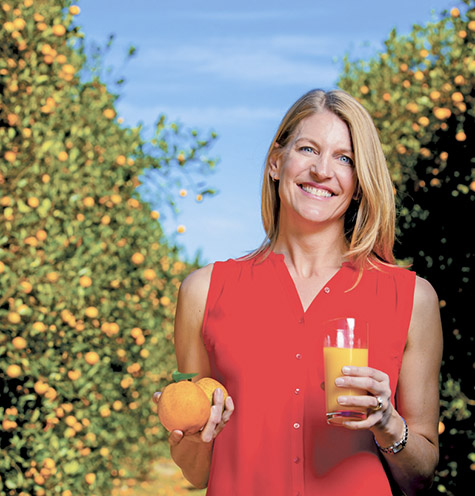
“Working with the Florida Department of Citrus, I’ve seen firsthand how much confusion there is around this topic for many families,” said registered dietitian Kate Geagan, author of “Go Green Get Lean.” “Yet while too many added sugars can fill your diet with ‘empty calories,’ naturally occurring sugars are found in some of nature’s most nutrient-rich packages, delivering a bevy of benefits such as vitamins, minerals, antioxidants and more.”
An 8-ounce glass of 100 percent orange juice, for instance, has no added sugar. Beyond being an excellent source of vitamin C, it’s a good source of folate, especially important for women of childbearing age, as well as potassium, a vital mineral which helps nerves and muscles communicate and can help offset the effects of too much sodium in the diet. In fact, the FDA recently announced it will add potassium to the Nutrition Facts Panel because many Americans are falling short.
The benefits don’t stop there, though. A glass of 100 percent orange juice also delivers magnesium, vitamin A and niacin. Plus, it’s a significant source of hesperidin, an antioxidant that research suggests may have heart, blood pressure and cognition benefits, as well as reduce inflammation and oxidation. Furthermore, one glass counts as one serving (1 cup) of fruit to help you meet the 1.5-2 cups per day recommended by the Dietary Guidelines for Americans.
How much added sugar is too much?
A delicious, vibrant eating plan that you can stick with for the long haul doesn’t mean you can’t ever consume added sugar, but it is about cutting back for most Americans – especially for groups with the highest intakes, such as adolescents and men – and replacing those calories with nutrient-rich foods.
The most recent Dietary Guidelines for Americans recommend limiting added sugar intake to a maximum of 10 percent of total calories each day, or 200 calories of a 2,000 calorie diet, which matches guidelines from the World Health Organization and the American Heart Association.
Clearing up food label confusion
In May 2016, the FDA announced a revamped Nutrition Facts Panel that includes, among other improvements, clearly listing added sugars on their own line for the first time.
Up until now, both added and naturally occurring sugars have been lumped together under one “sugars” line, making it vexing for the average eater to determine how much sugar is naturally occurring versus added, especially given the dozens of different names for sweeteners that manufacturers often use. When this change hits supermarket shelves, families will be able to more easily spot foods and beverages that contain little to no added sugar.
In addition to highlighting added sugars and potassium, the Nutrition Facts Panel will now more accurately reflect serving sizes that Americans actually eat and drink. Also, packages that are reasonably consumed in a single sitting will no longer get a free ride using smaller serving sizes and listing multiple “servings” per bag, container or can.
For best results, focus on filling your diet with an abundance of naturally nutrient-rich foods and shift to a diet that includes plenty of plant foods. For more recipes using Florida orange juice, visit floridacitrus.org.
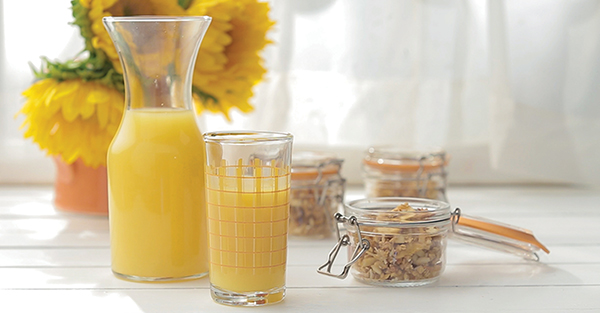
Homemade Orange Granola
Servings: 6
- 1 1/2 cups quick cooking oatmeal
- 1 cup chopped walnuts
- 1/2 cup sliced almonds
- 1/4 cup sunflower seeds or pumpkin seeds
- 1 1/2 teaspoons cinnamon
- 1 cup 100 percent Florida orange juice, divided
- 3 tablespoons canola oil
- 2 tablespoons honey
- 1 1/2 teaspoons vanilla extract
- 1/2 cup dried cranberries
- Heat oven to 325°F. Spray baking sheet with non-stick cooking spray.
- In large bowl, combine oatmeal, walnuts, almonds, sunflower seeds and cinnamon; mix well. Drizzle in 1/3 cup orange juice; stir well to evenly coat oatmeal mixture.
- Repeat twice more, stirring after each addition of orange juice.
- In small bowl, combine oil, honey and vanilla; stir well to combine. Drizzle oil mixture over oatmeal mixture; stir well to coat oatmeal mixture.
- Spread oatmeal mixture on prepared baking sheet in even layer. Bake 30 minutes, stirring every 10 minutes, to evenly brown granola.
- Remove from oven, add cranberries and cool completely. Store in airtight container up to one week.
Serving suggestion: For a morning parfait, serve homemade orange granola with milk or a dollop of plain Greek yogurt. Add in sliced fruit for extra color.
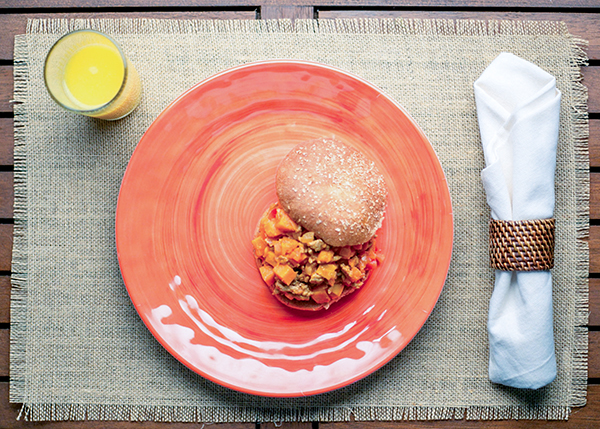
Sloppy O Joes
Servings: 4
- 9 ounces lean ground turkey
- 1/2 large minced onion
- 1 small red bell pepper, minced
- 1 teaspoon cumin seed, ground
- 1 teaspoon coriander seed, ground
- 1 cup Florida orange juice
- 1 cup organic tomato juice
- 1 large sweet potato, baked and diced
- 4 whole wheat dinner rolls
- In medium saute pan, saute ground turkey over medium heat until cooked thoroughly. Remove turkey; reserve.
- Saute onion until translucent. Add red pepper, cumin and coriander; saute for 1 minute then add orange juice. Cook until orange juice is reduced by two-thirds; add tomato juice and cooked turkey.
- Cook until tomato juice has reduced by two-thirds then add diced baked sweet potato and stir until combined.
- Split dinner rolls in half; spoon turkey mixture in center. Serve immediately.
Source: Florida Department of Citrus
Sensible Snacks that Really Pop
(Family Features) Next time you reach for a snack, go for a great-tasting option that delivers on both flavor and nutrition. Sensible snacks can be surprisingly delicious when you choose ingredients wisely.
One pop-ular choice: popcorn. Ideal for between-meal snacking since it satisfies but doesn’t spoil the appetite, popcorn is also the perfect addition to treats such as snack bars and trail mix. The key to smart snacking is finding good-for-you ingredients that make your body healthy and your taste buds happy.
With no artificial additives or preservatives, popcorn is naturally low in fat and calories. The whole grain provides energy-producing complex carbohydrates and contains fiber, providing roughage the body needs in the daily diet.
Find more healthy snack solutions at popcorn.org.
Perfect Popcorn
There’s nothing like the taste of freshly popped popcorn and nothing like the disappointment of burnt popcorn. Follow these simple steps and you’ll have perfect popcorn every time.
- Whether on the stove or in the microwave, popcorn will begin popping in a few minutes.
- When the popping begins to slow, listen until you can count two seconds between pops. Remove the pan from heat or bag from microwave.
- Remember to lift the lid or open the bag away from your face to prevent steam burns.

Oatmeal Raisin Cookie Corn
Yield: 10 cups
- 8 cups popped popcorn
- 3 tablespoons melted butter
- 2 tablespoons granulated sugar
- 1 teaspoon ground cinnamon
- 1 cup crunchy granola
- 1 cup raisins
- 1 cup walnut halves
- In bowl, toss popcorn with melted butter.
- Combine sugar with cinnamon; sprinkle over popcorn. Toss with granola, raisins and walnuts until combined.

Crispy Crunchy Apple Popcorn
Yield: 7 cups
- 6 cups popped popcorn
- 1 tablespoon butter, melted
- 2 teaspoons sugar
- 1/2 teaspoon cinnamon
- 2 cups dried apple chips
- Heat oven to 300° F.
- Line 9-by-13-inch baking pan with foil; butter foil. Spread popcorn in pan and drizzle with melted butter; toss popcorn. Sprinkle popcorn with sugar and cinnamon, and toss again.
- Bake 7 minutes.
- Sprinkle apple chips over popcorn and heat an additional 3 minutes.
- Serve warm, or cool to room temperature. Store in airtight container.

Crunchy Popcorn Trail Mix
Yield: 9 cups
- 5 cups popped popcorn
- 3 cups whole-grain oat cereal
- 1/3 cup raisins
- 1/3 cup peanuts (or other nuts)
- 1/3 cup sunflower seeds
- 1/4 cup (1/2 stick) butter or margarine
- 6 tablespoons brown sugar
- 2 tablespoons light corn syrup
- In large, microwavable bowl, stir together popcorn, cereal, raisins, nuts and seeds; set aside.
- In small saucepan, combine butter, brown sugar and corn syrup. Heat until boiling; cook 3 minutes, stirring occasionally.
- Pour over popcorn mixture, stirring to coat evenly. Microwave 3-4 minutes, stirring and scraping bowl after each minute.
- Spread onto greased cookie sheet; cool.
- Break into pieces and store in airtight container.

Popcorn Granola Snack Bars
Yield: 16 bars
- Nonstick cooking spray
- 1/2 cup honey
- 2/3 cup peanut butter
- 1 cup granola cereal
- 1 cup roasted and salted peanuts
- 3 cups popped popcorn
- Line 8- or 9-inch square baking pan with foil. Spray foil lightly with cooking spray; set aside.
- In large saucepan, heat honey until boiling. Stir in peanut butter until well blended.
- Remove pan from heat and stir in granola, peanuts and popcorn until coated. Press mixture evenly into prepared pan.
- Refrigerate until cool; cut into bars to serve.

Yummy Yogurt Popcorn
Yield: 2 1/2 quarts
- 2 1/2 quarts popped popcorn
- 1 cup plain yogurt
- 1 cup brown sugar
- 1/3 cup light corn syrup
- In large bowl, keep popped popcorn warm.
- In 2 1/2-quart saucepan, combine yogurt, brown sugar and corn syrup. Cook and stir over medium heat to hard ball stage (250° F on candy thermometer).
- Pour over popped popcorn, stirring to coat.
Source: The Popcorn Board






